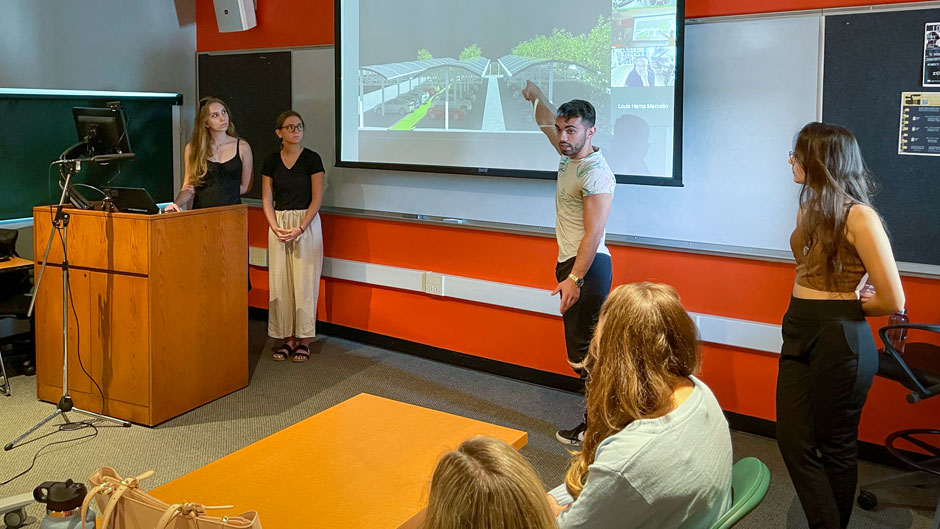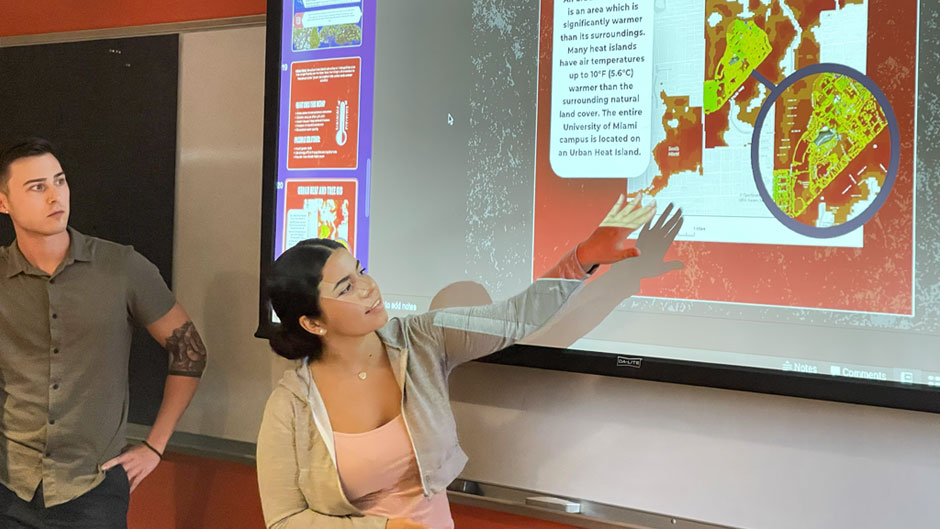Parking lots covered with solar panels that would also collect rainwater. More rooftop gardens across the Coral Gables Campus. Permeable sidewalks that allow rain to seep through them, and a canopy over the Fate Bridge.
These were just a few ideas that students in the University of Miami’s first undergraduate climate resilience class proposed, after they were challenged to evaluate things like flood risk, tree canopy, and heat index on the Coral Gables Campus and then to offer some viable options to make it a more sustainable place to work and study.
“This class opened my eyes about how many ways there are to deal with the impacts of climate change,” said sophomore Eva Klovatskiy, who is studying architecture. “It’s also beneficial for us to understand where we are headed, and I appreciate understanding that better.”

Created by a team of faculty members with expertise in different climate-related issues, the interdisciplinary course represented an overhaul of past teaching methods. Rather than in-class lectures, students in the course were required to watch cinematically produced videos filmed across South Florida with 13 different faculty experts in climate resilience before class each week.
They learned from associate professor Robin Bachin, who is founding director of the Office of Civic and Community Engagement and an urban and environmental historian focused on issues like affordable housing, climate gentrification, and how sea level rise is impacting development. That was a few weeks after they spent time with meteorologist Sharanya Majumdar, who studies how hurricanes and tropical cyclones form and intensify to improve prediction models.
“This class introduces students from a variety of majors to ways that they can all come together to discuss and problem solve—with a new perspective in situations dealing with climate resiliency,” said Gianell Gonzalez, a graduate architecture student, who served as a teaching assistant for the class.
During class time, students met with the faculty experts featured in the videos and also got a chance to engage with some industry experts through a virtual field trip. Then, instructors gave student teams a problem to solve related to that week’s climate-related topic. They were required to use a strategy called design thinking to address the issue—such as the degradation of coral reefs, sustainable architecture and urban planning, hurricane forecasts, and coastal engineering. Three teaching assistants, along with film professor Ali Habashi, and class coordinator Jared Zemantauski—who also taught a section on climate law—guided students through the strategy.
“Unfortunately, you have inherited a big problem, but through your knowledge, you can help our public leaders to drive change on your behalf and promote action in positive directions,” said Sonia Chao, research associate professor in the School of Architecture and one of the creators of the class.
Habashi, an assistant professor of practice in cinematic arts at the School of Communication, also helped create the class and produced the video modules.
“We hope you walk away with effective design thinking strategies to face and analyze complex climate issues as they evolve,” said Habashi, an award-winning filmmaker. “These are issues that we must be thinking about in multifaceted ways, with faculty outside your chosen area of expertise. Through these intersections you can learn more and embrace uncertainty.”
Formed as an outgrowth of the University’s Climate Resilience Academy, the course was launched this fall and its creators hope to improve the class and update its content with time. Although it was a lot of information in a short amount of time, many students were interested in delving further into climate-related topics.
“I realized that climate change isn’t just climate change, but there are also a host of social issues and associated environmental issues related to it,” said Owen Kellerman, a first-year architecture student.
As students presented their capstone projects last week, they drew upon the knowledge and data they had learned to navigate through the class for their presentations. Most had a strong understanding of the “urban heat island effect,” which occurs when cities replace natural land cover with a density of concrete buildings, roads, and sidewalks. The concentration of pavement absorbs and retains heat, and this often encourages urban temperatures to rise well above those in areas with more greenspace.
Students also learned to map out tree canopy data using geographic information systems software from two data scientists—Timothy Norris, associate professor of library science, and Chris Mader, senior director of software engineering at the University’s Institute for Data Science and Computing. They also got a quick primer on how to create accurate and effective data visualizations from associate professor Alberto Cairo, an expert in the field and the Knight chair in Visual Journalism. That led student Marin Yang, a senior studying geographic and sustainable development as well as ecosystem science and policy, to create an interactive campus tree canopy map for his team’s project.
First year architecture student Jesse Jones enrolled in the class because he is interested in sustainable building. But until taking the course, Jones—who grew up in Illinois—didn’t realize the magnitude of climate issues in Miami.
“This class has helped make me aware of a lot of issues like climate justice, the problems with coral reefs, or the impact of climate change on hurricanes and storm surge,” he said. “These are not things I had learned about before and it was awesome to have such high-quality faculty sharing the cutting-edge research they are doing, so we could learn what’s actually going on in these fields today.”
The course will be offered again during the spring semester. Watch a video about the class, or visit its webpage to learn more.

